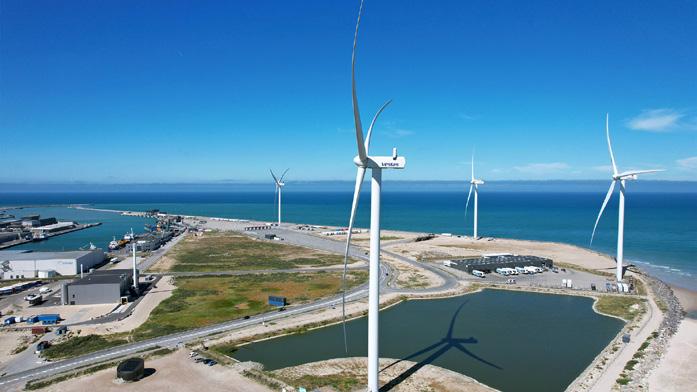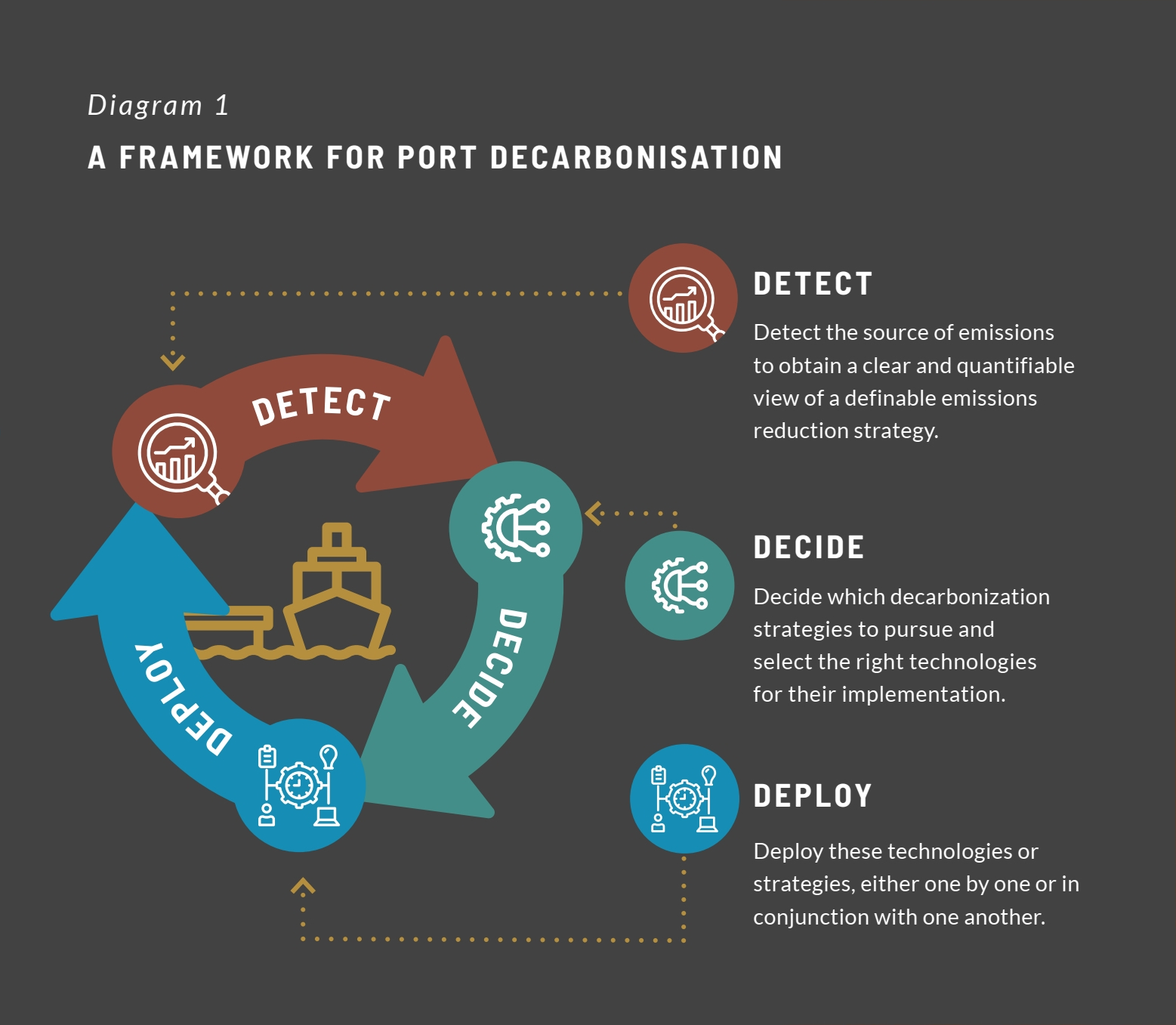
10 minute read
Detect > decide > deploy. How to create a net-zero port decarbonisation framework
by Ewa Kochańska
Decarbonising ports is a critical step in achieving worldwide sustainability goals and addressing climate change. Therefore, as pivotal hubs in the global supply chain, ports face mounting pressures and challenges in balancing efficiency with sustainability. The report Getting Ports to Net Zero, summarising a research project by Thetius and Ericsson, clears a concrete pathway leading to carbon-free operations. It describes a systemic approach, beginning with the detection of emission sources, followed by informed decision-making on technologies and funding needs, and effective, thoughtful deployment of solutions. Highlighting advanced monitoring systems and smart technologies, electrification and renewable energy integration, the publication examines implementation factors as well as real-life case studies, allowing ports to identify a proper strategy that best suits their operational framework.
Subpar port performance disrupts logistics and inflates end costs, while significant greenhouse gas emissions damage ecosystems and degrade the quality of life for surrounding communities. With that in mind, the complexity of port ecosystems makes reducing emissions a daunting and, at times, ambiguous task.
Getting Ports to Net Zero explores decarbonisation strategies that include smart technologies, electrification, and renewable energy, also highlighting the critical role that advanced networks play in achieving net-zero goals. Additionally, robust infrastructure, stakeholder collaboration, phased implementation, and continuous evaluation are also pointed out as critical to successful emissions reduction. To encompass all this intricacy in a user-friendly guide, the report narrows down the port decarbonisation framework to three main pillars: detect, decide, and deploy.

Detect
Detection is an obvious first step on the road to reducing and, later, eliminating emissions. Ports must pinpoint their most significant sources thereof to address the problem effectively, and there could be many: quay cranes and other cargo handling equipment, harbour vehicles, port facilities (like warehouses and workshops), as well as visiting vessels, trucks, and trains. Being able to deduce who the main offenders are allows ports to identify what is done well and what areas need improvements. This also involves determining whether the existing infrastructure is sufficient for implementing reduction measures or if upgrades are necessary. Sharing these findings with other ports and stakeholders promotes transparency and offers valuable insights into effective strategies, fostering collective progress in reducing environmental impacts. While ports differ, requiring individual approaches, they also share many touch points to make decarbonisation a group effort.
Getting Ports to Net Zero advises that creating a baseline for emissions and port performance is critical to setting realistic reduction targets. Importantly, having current data on emissions (and related achievements as well as failures) and sharing that information not only builds public trust but also ensures compliance with regulations. Currently, despite increasing awareness of the need for decarbonisation, few ports publicly disclose their emission data sets. A richer statistics base could better inform environmental policies and help in regulatory compliance across the entire maritime & logistics supply chains.
Measuring emissions is also tied to financial incentives and penalties, such as carbon taxes imposed based on CO2 outputs. Port players can mitigate these fees by adopting greener practices like using low-emission fuels, installing shore power systems, and promoting efficient vessel call scheduling and truck arrival times. These measures not only reduce emissions but also support compliance with goals like the European Green Deal (which aims for a 90% reduction in emissions by 2050). Compliance with these regulations is essential for securing funding and avoiding reputational damage. Advanced technologies enable precise emissions monitoring and improved operational efficiency. Digital tools like sensors, drones, and air quality monitors provide real-time data on pollutant levels, while remote sensing and satellite technologies offer broader monitoring capabilities. Digital twins integrate real-time data to optimise port operations, such as berth planning and reducing inefficiencies and emissions.
These innovations require reliable connectivity to function adequately, ensuring seamless data collection and analysis. Consequently, robust connectivity and digitalisation are essential for decarbonising ports and, thus, sustainable maritime operations. Modern technologies, such as the Internet of Things (IoT), artificial intelligence (AI), and high-speed wireless networks, enable real-time decision-making and predictive analysis. High-quality connectivity is also vital for operating autonomous equipment and mobile assets within ports, driving greater efficiency while reducing emissions.
Decide
It is now time to pick out what solutions must be deployed to reach the net-zero emissions objective. Getting Ports to Net Zero underscores three ‘key routes to choose from:’ implementation of smart technologies, equipment electrification and shore power provision, and introduction/escalation of renewable energy.
The publication emphasises that prioritisation is essential when approaching the adoption of smart technologies. Instead of implementing every solution simultaneously, ports are encouraged to integrate one strategy at a time to evaluate its effectiveness. By measuring key performance indicators, they can determine whether the desired results are being met or if adjustments are required. This methodical process also underscores the importance of ongoing evaluation to ensure optimal performance of implemented technologies.
Smart technologies comprise a broad range of innovations, apart from the above AI and IoT also robotics, blockchain, and augmented & virtual realities (AR, VR). As these technologies become increasingly instrumental in society, the market for these tools is also expanding. As such, the port technology market projections, according to Thetius IQ, indicate an increase from $4.1 billion in 2022 to $11.5 billion by 2029. This growth reflects the increasing demand for efficient and sustainable port operations as well as the key role that smart technologies have been and will be playing in optimising port operations and minimising emissions.
Next-gen technologies have many uses in ports, and the possibilities are constantly evolving. Tools like digital twins allow ports to simulate and refine operations before implementing changes (including infrastructure investments), reducing energy consumption and emissions. Predictive maintenance enabled by tech like AR and VR allows engineers to use these tools to address upkeep with greater accuracy and speed, sometimes remotely. Such efficiencies not only save time but also decrease the environmental impact of emergency repairs. In addition, optimising the flow of cargo and vessels in ports can drastically reduce idle times and energy waste. Studies show that better communication between ship and shore, supported by automation and advanced planning systems, can eliminate inefficiencies. Digital twins and port management information systems further aid in aligning schedules and improving turnaround times. Clearly, by improving vessel call & handling times, streamlining traffic management, and enhancing equipment performance, ports become safer and more energy efficient.
The integration of 5G networks is, as such, critical in port hubs. High-speed and low-latency connections are essential for real-time data sharing, whether for remote crane operations or AR/VR applications. Ports equipped with robust networks can manage large quantities of data generated by sensors and IoT devices, ensuring seamless communication and efficient operations. Preparing the infrastructure to support these innovations is a vital step, as ports must invest in durable foundational elements to ensure safe and efficient operations.
Another route when creating a strategy for emissions reduction in ports could be electrification and shore power provision. The former is seen as a rapid path to decarbonisation, as it significantly and relatively quickly cuts pollution; many ports worldwide, especially in Europe, the US, and China, are embracing electrification to cut emissions. Here, too, technologies like 5G are essential, enabling real-time communication and efficient energy management through smart grids. These systems help balance energy demands, monitor usage, and optimise renewable integration. However, despite progress, challenges to electrification, like infrastructure limitations and ship compatibility, persist, necessitating upgrades and collaboration with third parties.
The third route when deciding on decarbonisation solutions is the utilisation of renewable energy sources such as wind and solar. Hydrogen, while expected to play a smaller role in the global energy mix, is also gaining traction in emission-cutting efforts. DNV predicts it will account for 0.5% of energy use by 2030 and 5% by mid-century, with significant investments projected in hydrogen production and pipelines. Offshore wind farms also allow ports to produce green hydrogen via seawater electrolysis. With appropriate piping systems, ports can use this clean hydrogen for industrial purposes and ship fuelling, offering a sustainable energy source for various logistics operations.
Hydropower (tidal turbines, wave energy converters) is another option. Getting Ports to Net Zero gives the example of the Port of Antwerp, which installed a water turbine in a lock, integrating the generated energy with solar and wind power into a smart grid. Notably, Antwerp was aided by VR in the initial planning and understanding of environmental conditions.
Nuclear power in maritime is another option that has recently been increasingly considered, according to DNV’s Maritime Forecast to 2050. Currently responsible for about 10% of global electricity, this option still faces safety and societal concerns. However, new small modular reactors offer safer and more adaptable designs, potentially providing energy to ports with lower initial costs. Ports near such facilities could use this energy with visiting ships after adapting infrastructure and connecting to the nuclear plant.
Additionally, ports are exploring advanced technologies like carbon capture and storage (CCS) to reduce emissions. This involves capturing industrial carbon output for storage, reuse, or export. Antwerp’s CCS project, launched in 2019, estimates it will be able to capture half of the port’s CO2 emissions by 2030. Digital tools, including machine learning and virtual models, are used to enhance the efficiency and feasibility of CCS.
Deploy
With well-defined decarbonisation and implementation goals, ports can finally begin shifting their operations, choosing from the options mentioned above. Successful implementation of new technologies means focusing on infrastructure needs, investments, stakeholder engagement, phased implementation, and ongoing monitoring of success metrics. Assessing infrastructure must factor in future upgrades and scalability to alleviate long-term costs. Building an investment case is pivotal, as securing funds always requires clear justification.
It can be helpful to highlight how private 5G networks improve operations in terms of security and efficiency. In this process, reaching out to various stakeholders, addressing specific benefits and outlining manageable, phased upgrades could produce good results. Also crucial at every step of the funding process is transparency on costs, network security challenges, and legacy system integration.
Further, adopting a phased approach to implementation is recommended as it minimises risks and costs while pilot projects demonstrate value, allowing for refinement and workforce training. This ensures smooth adoption and adaptation to new tools.
Engagement with stakeholders is also essential at every step; awareness of new technologies – and the benefits/drawbacks they offer – creates an atmosphere of open communication and trust. Getting Ports to Net Zero recommends involving all parties early on to address concerns, e.g., about automation’s impact on jobs. In this type of communication, it is important to emphasise how technology enhances operations and creates upskilling opportunities, fostering collective buy-in. Moreover, identifying and underscoring how new technologies or infrastructure changes can benefit all stakeholders is another critical piece of the puzzle. Forming partnerships with vendors who understand the port’s specific operational requirements is essential, too. Tailored solutions and partners with a proven track record can help overcome resource limitations and create a network that fosters data sharing and informed decision-making.
And lastly, measuring successes and failures to understand technological progress and assess and refine smart technologies must also become a part of the process. Well-made projects serve as benchmarks, while shortcomings provide learning opportunities for future improvements.
Getting the basics right
As centres of economic activity and gateways to international trade, ports have become key players in the global shift to sustainability. Thetius and Ericsson’s report underscores that ports aiming to decarbonise can make significant progress by adopting smart technologies, electrification, and renewable energy.
But the publication also cautions that ports must focus on getting the basics right before embracing advanced technologies. Robust infrastructure is a necessary foundation; skipping this step can lead to disappointing outcomes. By taking a gradual approach – first establishing infrastructure, then rolling out technologies, and scaling up efforts as benefits become clear – ports can ensure that their decarbonisation transition is efficient and effective.








